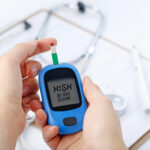
Anemia is a condition where the blood has fewer red blood cells or lower levels of hemoglobin, a protein that carries oxygen from the lungs to the rest of the body. When someone has anemia, their blood doesn’t carry as much oxygen as it should, leading to symptoms like fatigue, weakness, shortness of breath, dizziness, headaches, and irregular heartbeats. It can affect anyone, regardless of age, race, or ethnicity, though certain groups, such as those with cancer, autoimmune disorders, or heavy menstrual periods, are more at risk
Types of Anemia
Iron Deficiency Anemia
Iron deficiency anemia occurs when there is not enough iron in the diet, due to blood loss, or because the body has trouble absorbing iron. This is a common type of anemia, affecting 30% of women and children. Symptoms include fatigue, headaches, restless leg syndrome, heart problems, and pregnancy complications like early labor and low infant birth weight. Although rarely fatal, it can lead to significant health issues and worsen other medical conditions if untreated.
Pernicious Anemia
Pernicious anemia is an autoimmune disorder where the body attacks healthy cells, leading to a vitamin B12 deficiency. This type is rare, affecting less than 2% of people over 60 worldwide. Vitamin B12 is crucial for making healthy red blood cells and maintaining a proper nervous system. Without it, red blood cells become larger than normal and cannot effectively divide or move out of the bone marrow, causing serious complications like brain or nerve damage if untreated.
Aplastic Anemia
Aplastic anemia is a severe and rare condition where the bone marrow fails to produce enough new blood cells. This affects about two out of every million people in the United States and is often due to stem cell damage. Symptoms can include heart problems, bleeding issues, and an increased risk of leukemia. Without treatment, it has a high mortality rate, with about 70% of people dying within a year. However, with proper treatment, the five-year survival rate for those under 20 is about 80%.
Hemolytic Anemia
Hemolytic anemia occurs when red blood cells are destroyed faster than they can be replaced. This condition can be inherited or acquired, and its cause is sometimes unknown. It affects approximately 1-3 per 100,000 people annually and can occur at any age. Severe cases can lead to serious heart problems if not treated.
Symptoms of Anemia

Anemia symptoms vary based on its severity and how quickly it develops. Initial signs include pale skin and feeling weak or fatigued. As it progresses, symptoms might include dizziness, increased thirst, sweating, a rapid pulse, fast breathing, mouth symptoms like tongue swelling, dry mouth, and ulcers, brittle nails, and hair loss. Severe anemia can cause lower leg cramps, shortness of breath, and brain damage. Heart-related symptoms are common, as the heart has to work harder to supply oxygen-rich blood throughout the body.
What Causes Anemia?
There are three main causes:
- Lack of Red Blood Cell Production: Often due to nutritional deficiencies or poor nutrient absorption.
- High Rates of Red Blood Cell Destruction: Chronic conditions can cause the body to destroy red blood cells faster than it can produce them.
- Blood Loss: Heavy menstruation or internal bleeding, such as in the stomach or colon, can lead to anemia.
Risk Factors
Various conditions and genetic factors can increase the risk of developing anemia. These include:
- Diets low in iron, vitamin B12, or folic acid
- Frequent blood donation
- Heavy menstrual periods
- Pregnancy
- Cancer
- Ulcers
- Colon polyps or cancer
- Autoimmune disorders
- Inherited conditions
- Blood disorders like sickle cell disease
- Metabolic conditions
- Exposure to toxins
- Radiation and chemotherapy
- Viral infections like Epstein-Barr virus
Diagnosis
Diagnosis begins with a physical exam to check for signs like a pale tongue and brittle nails. Healthcare providers will ask about medical history, diet, and family history of anemia. Blood tests are common, including:
- Complete Blood Count (CBC)
- Mean Corpuscular Hemoglobin Concentration (MCHC)
- Mean Corpuscular Hemoglobin (MCH)
- Hematocrit Levels
- Mean Corpuscular Volume (MCV)
Other tests might include bone marrow tests, urine tests, genetic tests, and diagnostic tools like colonoscopy and endoscopy.
Anemia Treatments
Treatment varies depending on the cause and severity. The goal is to increase red blood cell count or hemoglobin, improve oxygen levels, relieve symptoms, and prevent complications.
- Diet: Eating iron-rich foods is essential for treating early or mild iron deficiency anemia. Iron is found in animal foods like meat, poultry, seafood, and eggs (heme iron) and in plant foods (non-heme iron). Combining these with vitamin C-rich foods like broccoli, oranges, and strawberries can enhance iron absorption.
- Supplements: Oral iron supplements are common, with intravenous iron therapy for severe cases. Vitamin B12 supplements or shots are used for pernicious anemia, with nasal gels and sprays as alternatives.
- Medications: These can treat the underlying condition causing anemia. Immunosuppressants may be prescribed for aplastic or hemolytic anemia, and erythropoietin therapy can stimulate red blood cell production.
- Blood Transfusions: Used for severe cases to quickly increase iron and red blood cell levels. This procedure takes 1-4 hours and includes monitoring before and after.
- Blood and Bone Marrow Transplants: For severe aplastic anemia, this involves replacing damaged stem cells with healthy ones after high doses of chemotherapy and possibly radiation.
- Surgery: May be necessary for internal bleeding or, in rare cases, removing the spleen in hemolytic anemia.
Prevention
Some types of anemia can be prevented, especially those due to vitamin or mineral deficiencies. Including iron-rich foods in your diet and combining them with vitamin C-rich foods can help. Avoiding triggers and managing conditions that can cause anemia are also essential. For example, addressing heavy menstrual periods with an OB-GYN can prevent anemia.
Living With Anemia
Anemia can often be managed with supplements, lifestyle changes, and medications, improving energy levels and quality of life. However, some types can be severe and long-lasting, requiring ongoing management to prevent serious complications.
Summary
Anemia is a condition marked by a lack of red blood cells or hemoglobin, leading to reduced oxygen levels in the blood. It has various types, each with specific causes, symptoms, and treatments. Early diagnosis and appropriate treatment are crucial for managing anemia and maintaining a good quality of life
A Quick Review
Anemia is a common blood disorder that reduces the number of red blood cells or hemoglobin in your blood, leading to symptoms like fatigue and weakness. It can be caused by various factors, including poor diet, chronic conditions, and significant blood loss. Treatment depends on the type and severity of anemia, ranging from dietary changes and supplements to more intensive interventions like blood transfusions and surgery. Early diagnosis and treatment are crucial for managing symptoms and preventing complications.











